Puffing Billy Railway
The Puffing Billy Railway is a 2 ft 6 in (762 mm) narrow gauge heritage railway in the Dandenong Ranges in Melbourne, Australia. The primary starting point, operations and administration centre, main refreshment room (also selling souvenirs) and ticket purchasing are located at Belgrave station. Journeys may also be commenced at out-stations of which some have limited facilities for the purchase of tickets, refreshments and souvenirs. Tickets may also be purchased from the conductor before boarding the train.
| Puffing Billy | |
|---|---|
.jpg.webp) Puffing Billy train at Belgrave station in 2002 | |
| Overview | |
| Connecting lines | Belgrave line |
| Former connections | Upper Ferntree Gully line |
| Stations | 11 |
| Service | |
| Type | Heritage Railway |
| System | Puffing Billy Railway |
| Services | 3 to 6 services daily (except Christmas Day) |
| Rolling stock | Victorian Railways narrow gauge |
| History | |
| Commenced | 1899 |
| Opened | 1900 |
| Completed | 1900 |
| Closed | 1954 |
| Reopened | 1955. Closed again 1958; reopened from 1962 in stages |
| Technical | |
| Line length | 15.6 mi (25.1 km) |
| Number of tracks | Single track |
| Track gauge | 2 ft 6 in (762 mm) |

General
The railway was originally one of five narrow gauge lines of the Victorian Railways opened around the beginning of the 20th century. It runs through the southern foothills of the Dandenong Ranges to Gembrook. Being close to the city of Melbourne and with a post-preservation history spanning over 50 years, the line is one of the most popular steam heritage railways in the world,[1] and attracts tourists from all over Australia and overseas.
The Puffing Billy Railway is kept in operation through the efforts of volunteers of the Puffing Billy Preservation Society, although intensive year-round operations have led to a few dozen paid employees to keep things going behind the scenes.
The railway aims to preserve and restore the line as near as possible to how it was in the first three decades of its existence, but with particular emphasis on the early 1920s.
Operation
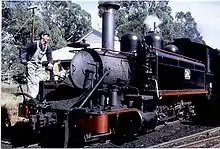
Operations are centred on Belgrave, which houses the main offices of the railway (other offices are located at Emerald) as well as the locomotive running shed and locomotive workshops. It is also the base for track maintenance operations.
Most trains start from Belgrave and travel to Lakeside, or to the terminus at Gembrook, and return. The railway operates every day of the year except Christmas Day, with at least three and up to six advertised services departing Belgrave each day. One service each day has the option of first-class carriages and lunch.
A semi-regular service is the Dinner Train, which usually departs Belgrave on a Friday or Saturday evening and travels to Nobelius Siding, where the passengers disembark and have a sit-down dinner in the converted packing shed of the former Nobelius Nursery. After the meal, the passengers rejoin the train for the return journey to Belgrave. Savouries and drinks are served on the train.
Once or twice a month, these Dinner Trains also incorporate a themed evening known as "Murder on the Puffing Billy Express". Passengers are encouraged to dress in 1920s-era costume and participate in a murder mystery which involves actors on board the train and concluding during the meal at Nobelius Siding. Prizes are on offer to guests who guess the murderer as well as best-dressed prizes.
A popular feature of a ride on Puffing Billy is sitting on the ledge of the open-sided carriages (see picture). As a result of a crash between a train and a minibus at the Menzies Creek level crossing on 5 March 2018,[2] this practice has been prohibited until further notice.[3]
There is also a narrow gauge railway museum adjacent to Menzies Creek station, which is currently closed for re-development.
Locomotives and rolling stock
Locomotives
The railway owns every remaining narrow gauge locomotive of the former Victorian Railways, and has restored to operating condition all except one, although not all are in serviceable condition at any one time. This fleet comprises five restored and one unrestored 2-6-2T NA class locomotives (3A is unrestored, while 6A, 7A, 8A, 12A and 14A have all been restored), and one G class Garratt locomotive (G 42). All are restored, or being restored, to represent different eras in their working life.
In December 2019 a completely rebuilt and re-gauged NG/G16 Garratt locomotive (NG/G16 129) originally imported from South Africa in 1996 entered service on the railway to complement the operational capabilities of the G class Garratt locomotive (G 42). The two Garratt locomotives (G 42 and NG/G16 129) can haul up to 16 carriages in a train whereas the NA class locomotives are limited to pulling 8 to 10 carriages.
The railway also has a number of other smaller steam locomotives from various sources in its museum collection, either on static display or in operating condition. These include a Peckett 0-4-0ST and Decauville 0-4-0T formerly from the West Melbourne Gasworks, and a Climax geared locomotive from the Tyers Valley Tramway. None of these locomotives is powerful or fast enough to operate on regular services, however, they can occasionally be seen on special trains and at events such as Thomas the Tank Engine days.
Puffing Billy also offers driver experience days on the smaller steam engines. The Climax engine has been restored for this purpose as this engine has a commodious driving cab and is unique in Australia.
The railway also operates three diesel locomotives which are used on days of total fire ban, plant or works trains, or when insufficient steam locomotives are available, including in emergencies. The diesel locomotives originally operated on railways in Tasmania (D 21, formerly V 12) and Queensland (DH 5, formerly DH 5 and later CC 02, and DH 31, formerly DH 59), and were regauged and rebuilt for use on the Puffing Billy Railway.
There is also a diesel Rail Tractor (NRT 1) used mainly for shunting rolling stock in association with the Carriage Workshops.
VR Original
| Image | Number | Type | Builder | Serial number |
Year built | Status | Notes |
|---|---|---|---|---|---|---|---|
| 3A | NA class 2-6-2T |
Newport Workshops | 1900 | Stored | The first of the VR-built NA class locomotives, built at the Victorian Railways Newport Workshops, utilising spare parts supplied with Baldwin-built 1A. Stored disassembled for future restoration. In 2015 it was placed on static display at the Menzies Creek Museum. In June 2020 it was moved to Lakeside for Display in the new Discovery Centre. | ||
 |
6A | NA class 2-6-2T |
Newport Workshops | 1901 | Operational | Has been restored as near as practicable to "as new" condition (1901–1906) of two-tone green with white lining, low-height bunker, extended side tanks, etc. It was fitted with Lempor Exhaust System between 2002 and 2017. | |
 |
7A | NA class 2-6-2T |
Newport Workshops | 1905 | Operational | Has been restored as near as practicable to "as new" condition (1905–1910) of "Canadian Pacific" red & brown with white lining, low-height bunker, small head lamps, etc. | |
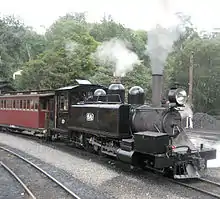 |
8A | NA class 2-6-2T |
Newport Workshops | 1908 | Operational | Has been restored as near as practicable to its 1923–1937 era of all-over black, modified front end with tapered smoke stack, large head lamps, extended bunker, etc. | |
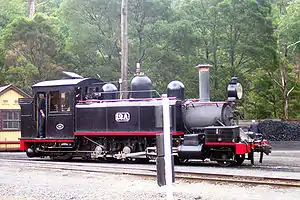 |
12A | NA class 2-6-2T |
Newport Workshops | 1912 | Operational | Has been restored as near as practicable to its 1911–1921 era of "Canadian Pacific" red & brown with white lining and low-height bunker, however has been given the large-style headlamps rather than the small head lamps, plus a full-width ash chute rather than the narrow ash chute. | |
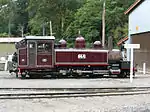 |
14A | NA class 2-6-2T |
Newport Workshops | 1914 | Operational | Has been restored as near as practicable to its later era (1938–1946) of all-over black, extended bunker, large head lamp, guard irons instead of cow-catchers, etc. It underwent conversion to oil firing during 2017 and testing in early 2018 before full return to service. | |
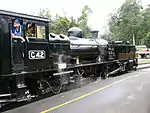 |
G 42 | G class 2-6-0+0-6-2 |
Beyer Peacock | 6268 | 1926 | Operational | The last remaining G class Garratt locomotive from the Victorian Railways. Restored to steam in 2004 as near as practicable to its 1946–1954 era of all-over black with extended cab roof, original style smoke stack, kerosene-style lamps, cow-catcher, mid-height marker lamps, etc. |
Other steam
| Image | Number | Type | Builder | Serial number |
Year built | Status | Notes |
|---|---|---|---|---|---|---|---|
| 129 | NG/G16 2-6-2+2-6-2 |
Beyer Peacock | 7430 | 1951 | Operational | South African Railways 2 ft (610 mm) gauge NG/G16 Garratt locomotive, imported to Australia in 1996. Completely rebuilt and re-gauged to 2 ft 6 in (762 mm) gauge as a backup for G 42. Entered service in December 2019. | |
 |
1694 | Climax, Two-truck |
Climax Locomotive Works | 1694 | 1928 | Operational | Climax geared steam locomotive, the last built and the only one ever built to 2 ft 6 in (762 mm) gauge. Purchased by the Forests Commission Victoria and used on the Tyers Valley Tramway to haul timber trains until 1949. After decommissioning the locomotive in the 1950s it was stored (abandoned) at the State Sawmill site at Erica until it was transferred to Puffing Billy's museum for static display in 1965. Restored to steam by the PBR in the 1980s. A major overhaul has been finished and it returned to service Sunday 8 September 2013.[4] |
| 861 Decauville | 2-4-2ST | Couillet for Decauville | 1886 | Operational | Previously owned by Melbourne Metropolitan Gas Company for use at the West Melbourne Gasworks. Extensively rebuilt in the 1970s as part of an attempt to restore a section of the Walhalla railway line. Privately owned and leased to the PBR. Used on Footplate Experience Trains. | ||
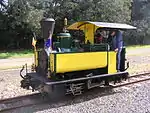 |
986 Carbon | 0-4-0T | Couillet for Decauville | 1890 | Operational | Previously owned by Melbourne Metropolitan Gas Company for use at the West Melbourne Gasworks. Used at a park in Frankston in the 1970s. Privately owned and leased to the PBR. | |
| Peckett 1711 "Sir John Grice" | 0-4-0ST | Peckett and Sons | 1711 | 1926 | Operational | Previously owned by Melbourne Metropolitan Gas Company for use at the West Melbourne Gasworks. Often used at PBR decorated for Thomas the Tank Engine events. It has also run in an alternate guise as "Peter Peckett" from 1991–1999. | |
.jpg.webp) |
127 | NG G16 2-6-2+2-6-2 |
Beyer Peacock | Stored | South African Railways 2 ft (610 mm) NG G16 Garratt locomotive previously used on the Banana Express, imported to Australia in 2012. Currently in storage as a source of spare parts for sister locomotive 129 and for possible future rebuild and regauging to 2 ft 6 in (762 mm) gauge as a second backup for G 42. | ||
| 14 Shay | Shay Two-truck |
Lima Locomotive Works | 1912 | Stored | Shay geared locomotive formerly used on the Alishan Forest Railway in Taiwan. Imported to Australia for preservation in the 1970s. On Display in the Menzies Creek Museum. | ||
| 3 Sub Nigel | 0-6-0WT | Orenstein & Koppel | 12331 | 1931 | Stored | Formerly used by the Sub Nigel Gold Mining Company Ltd. in South Africa. On Display in the Menzies Creek Museum. | |
Carriages
The mainstay of the carriage fleet are the 15 NBH open-sided carriages built specially for tourist traffic on the Gembrook line by the VR between 1918 and 1919, and a further 10 vehicles built to the same or similar design in the preservation era. However, there are also a number of enclosed carriages, both saloon and compartment cars. In addition, four carriages were obtained from the Mount Lyell Railway in Tasmania after its closure in 1963, and regauged and reclassified for Puffing Billy use, numbered 1–4NAL. They are named Mt Lyell, Double Barril, Rinadeena & Teepookana to reflect their Tasmanian Heritage. These vehicles are now used as first-class carriages and used primarily on the Luncheon train and Dinner train.
Several carriages have been temporarily converted to include a guard's compartment. A number of NQR low-sided goods trucks have also been modified for passenger use, making them similar to the NBH carriages. Another three NQR trucks have been fitted with seats but no roof and are only used during the summer peak season.
| Number | Image | Year built | Builder | Status | Notes |
|---|---|---|---|---|---|
| NB | 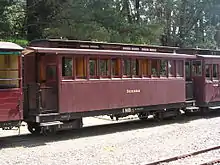 |
||||
Goods vehicles and brake vans
Representatives of all classes of goods vehicles and brake vans (including combined brake van and passenger carriage) used on the narrow gauge lines of the Victorian Railways are to be found on the Puffing Billy line, and are used for works trains, storage, and occasional heritage trains recreating the look of trains in the 1920s.
Structure

Puffing Billy Preservation Society
When the Puffing Billy Preservation Society was formed in 1955, the line was still under the control and ownership of the Victorian Railways (VR). The Society arranged for the VR to run the train on weekends and holidays, with the Society guaranteeing the VR against losses from insufficient ticket sales. Society volunteers took the role of conductors, checking tickets on the train, and fund-raising. This arrangement continued until the Upper Ferntree Gully to Belgrave section was closed in 1958.
When the line reopened in 1962 (between Belgrave and Menzies Creek), Society volunteers took a larger role, manning stations, selling and checking tickets, and doing non-safety-critical maintenance on the train, and track maintenance under the supervision of a VR ganger. Ticket revenue went into an account on which the VR drew to pay for their staff involved in running the line.
Emerald Tourist Railway Board
The Victorian Railways were not in the preservation business, and the arrangement was less than ideal, so in 1977 the Victorian Government passed the Emerald Tourist Railway Act 1977 (No. 9020) to set up the Emerald Tourist Railway Board as a statutory authority to take over ownership and operation of the railway from the VR. The Act requires that the Board have between five and ten members, four of which are to be nominated by the Puffing Billy Preservation Society. Successive governments have had sufficient confidence in the Board that they have never appointed their full entitlement, effectively leaving control of the Board in the hands of Society nominees.
With the Board, volunteers were now able to take on more responsible roles, including filling the positions of signalmen, guards, and firemen, and later drivers, although the Board does employ staff drivers to provide the core of the driving tasks. All volunteers filling responsible positions are required to undergo training and testing in their responsibilities.
History

Pre-preservation
The line was opened in 1900 to serve the local farming and timber community. It originally ran from Upper Ferntree Gully station, the terminus of the broad gauge line from Melbourne and now part of Melbourne's suburban railway system, but it now begins at Belgrave.
The train, known to the locals as "Puffing Billy" amongst other names, stopped running in 1953 after a landslide blocked the line between Selby and Menzies Creek, and it was formally closed in 1954.[5] Today the former line between Upper Ferntree Gully and Belgrave is serviced by Metro Trains Melbourne suburban electric trains, while the line beyond Belgrave has been reopened by the Puffing Billy Preservation Society.
At the end of 1954, the railways desired a scheme to minimise their financial risks if the train was to run indefinitely. Harold L. Hewett, a teacher at Melbourne Grammar School, was the driving force behind a small group of people who organised a rally attended by 400 people at Upper Ferntree Gully station on 4 January 1955 to try to save the train
Post-preservation
Following closure, a few "farewell specials" operated on the remaining usable section to Belgrave, which proved very popular. On 1 October 1955, the Puffing Billy Preservation Society was formed to keep the train running indefinitely. This continued until 1958 when the line to Belgrave was closed for conversion to a broad gauge, electrified suburban line. The society then started work on restoring the Belgrave to Lakeside section, and on 28 July 1962, restored train operation between Belgrave and Menzies Creek.
Rover Scouts attending the 7th World Rover Moot held at Wonga Park assisted in the clearing of the line between Belgrave and Menzies Creek as part of the event's community service component.[6]
Subsequently, operations were gradually extended over the remainder of the original line through Clematis to Emerald in 1965 and Lakeside in 1975 before reaching Gembrook, which was completed in 1998, reopening on 18 October of that year.
Today the railway operates daily (except for Christmas day) as a popular tourist activity over 15 miles (24 km) with original steam engines, and is operated with some of the railway practices from the Victorian Railways 1900 to 1930 era, such as using the "Staff and Ticket" safeworking method and having conductors on board the trains. In the 2016/17 financial year, Puffing Billy carried 487,237 passengers, up more than 60,000 from the previous financial year.
Scandal
In 2014, Robert Whitehead, a long-serving volunteer on the railway, was convicted of multiple sexual offences against young boys. He died in prison in 2015, while serving a sentence of more than 8 years.[7] Whitehead had been convicted and jailed in 1959 of molesting a boy scout, but returned to his job on the railways at the request of Sir Murray Porter. He joined the Puffing Billy Railway as a volunteer in 1961[8] and rose to become Secretary of the Puffing Billy Preservation Society. He used his position to meet and molest boys into the 1990s.[9] In 2018, the ombudsman's report on the case found that the board of the railway had known about Whitehead's activities and had actively protected him.[8]
Volunteers

Without the input of hundreds of volunteers who put themselves on rosters for a wide range of duties, the line would not be economical. Although there are also paid staff involved in maintaining the train and its line, performing support roles such as accounting and advertising, and providing the backbone of the driving duties, volunteers are involved in almost all aspects of running the train including manning stations, selling tickets, maintaining the track and trains, driving and other safeworking duties such as acting as fireman and guard on the trains and signalman at some stations. Volunteers also help to maintain buildings, grounds and stations. Many of these roles involve being trained for positions of responsibility.
In line with the policy of representing the 1900–1930 era, the roles carried out by the volunteers use traditional Victorian Railways titles such as those listed below:—
- Station-master
- Booking Clerk /ˈklɑːrk/[10]
- Porter
- Conductor
- Driver
- Fireman
- Guard
- Signalman
- Steward
In popular culture
Television
Solo One was a TV police drama series produced by Crawford Productions that screened in 1976, filmed and set in Emerald, Victoria, about a local (fictional) policeman dealing with crime in the town, however it was aimed at a younger audience than most Australian TV police dramas. It featured Puffing Billy in the opening credits scene as well as being part of most story-lines.
The ABC children's drama Come Midnight Monday was filmed in and around Belgrave, Emerald & Cockatoo and featuring Puffing Billy locomotive 12A—renamed "Wombat"—as the main character.
Filming of A Country Practice in the fictional town of Wandin Valley (the towns of Wandin, Wandin North and Wandin East are however 30 km north of Emerald) was moved to Emerald when the show moved to Network Ten, and occasionally featured Puffing Billy.
The 1966 television special The Seekers at Home filmed a segment at Puffing Billy, where the Seekers sing "Morningtown Ride" to a group of children.[11]
In 1997, the soap opera Neighbours filmed scenes set on and around the train. The characters of Darren Stark and Libby Kennedy lost young Louise Carpenter and chased after the train en route to Belgrave on a motorbike to catch up with her after discovering she had boarded it.
Books
A couple of children's story-books have been published featuring Puffing Billy, telling the story of its rescue, but with a great deal of artistic license.
Line guide
Puffing Billy Railway | |||||||||||||||||||||||||||||||||||||||||||||||||||||||||||||||||||||||||||||||||||||||||||||||||||||||||||||||||||||||||||||||||||||||||||||||||||||||||||||||||||||||||||||||||||||||||||||||||||||||||||||||||||||||||||||||||||||||||||||||||||||||||||||||||||||||||||||||||||||||||||||||||||||||||||||||||||||||||||||||||||||||||
|---|---|---|---|---|---|---|---|---|---|---|---|---|---|---|---|---|---|---|---|---|---|---|---|---|---|---|---|---|---|---|---|---|---|---|---|---|---|---|---|---|---|---|---|---|---|---|---|---|---|---|---|---|---|---|---|---|---|---|---|---|---|---|---|---|---|---|---|---|---|---|---|---|---|---|---|---|---|---|---|---|---|---|---|---|---|---|---|---|---|---|---|---|---|---|---|---|---|---|---|---|---|---|---|---|---|---|---|---|---|---|---|---|---|---|---|---|---|---|---|---|---|---|---|---|---|---|---|---|---|---|---|---|---|---|---|---|---|---|---|---|---|---|---|---|---|---|---|---|---|---|---|---|---|---|---|---|---|---|---|---|---|---|---|---|---|---|---|---|---|---|---|---|---|---|---|---|---|---|---|---|---|---|---|---|---|---|---|---|---|---|---|---|---|---|---|---|---|---|---|---|---|---|---|---|---|---|---|---|---|---|---|---|---|---|---|---|---|---|---|---|---|---|---|---|---|---|---|---|---|---|---|---|---|---|---|---|---|---|---|---|---|---|---|---|---|---|---|---|---|---|---|---|---|---|---|---|---|---|---|---|---|---|---|---|---|---|---|---|---|---|---|---|---|---|---|---|---|---|---|---|---|---|---|---|---|---|---|---|---|---|---|---|---|---|---|---|---|---|---|---|---|---|---|---|---|---|---|---|---|---|---|---|---|---|---|---|---|---|---|---|---|---|---|---|---|---|---|---|---|
| |||||||||||||||||||||||||||||||||||||||||||||||||||||||||||||||||||||||||||||||||||||||||||||||||||||||||||||||||||||||||||||||||||||||||||||||||||||||||||||||||||||||||||||||||||||||||||||||||||||||||||||||||||||||||||||||||||||||||||||||||||||||||||||||||||||||||||||||||||||||||||||||||||||||||||||||||||||||||||||||||||||||||
Regular Puffing Billy services usually only stop at stations shown in bold print at the right. Stops at other stations can be made by request. Distances are from Southern Cross station.
Bibliography
References
- Friends of the Trestle Bridge, Puffing Billy, Sherbrooke
- http://www.abc.net.au/news/2018-03-06/puffing-billy-crash-at-menzies-creek/9518658
- http://www.heraldsun.com.au/news/victoria/puffing-billy-collides-with-bus/news-story/e01682283994501147bc06cea98debb2
- "Climax 1694 steams again". Puffing Billy Preservation Society. Archived from the original on 24 June 2014. Retrieved 24 June 2014.
- Reminiscences of the Upper Ferntree Gully–Gembrook Narrow Gauge Line Clark, M.H.W. Australian Railway Historical Society Bulletin, April, 1980 pp69-83
- Milne, A. R.; Heward, C.B. Those Boy Scouts – A Story of Scouting in Victoria. Melbourne: Victorian Scout Archives, Scouts Australia - Victorian Branch. pp. 151–152. ISBN 0949873141.CS1 maint: ignored ISBN errors (link)
- Flower, Wayne (23 July 2015). "Robert Whitehead, Puffing Billy paedophile jailed for child sex attacks". Herald Sun.
- Eddie, Rachel (25 June 2018). "Puffing Billy paedophile facilitated by indifference, ineptitude: Ombudsman". The New Daily.
- Baker, Richard; McKenzie, Nick (28 June 2017). "Probe into claims Puffing Billy paedophile Robert Whitehead had high-level protection". The Age.
- / Dictionary.com
- http://www.allmusic.com/album/at-home-and-down-under-mw0001082354
- http://www.antiqbook.com/boox/out/95258.shtml
- http://www.invaluable.com/auction-lot/book:-vic.:-downes,-speed-limit-20-,-130pp,-the-1-c-vmvgq8vpjd
- http://catalogue.nla.gov.au/Record/2081320 National Library of Australia—record
External links
| Wikimedia Commons has media related to Puffing Billy Railway, Melbourne. |